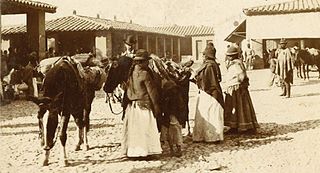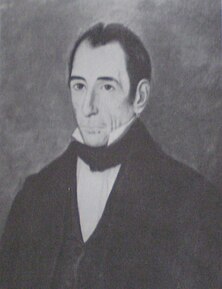The Charca villagers were an Aymara speaking indigenous ethnic group who lived in what is called today El Departamento de Chuquisaca in Bolivia. From the 15th century they were citizens of the Inca Empire. They regularly suffered from invasions of the people of ava guarani (who spoke an Aymaran language) that inhabited the Chuquisaca Department of Bolivia prior to the arrival of the Spaniards. They also suffered from incursions of the Chiriguanos.
Portuguese conquistador Aleixo Garcia is believed to be the first European to make contact with the Charcas in the year 1525.
The city of Sucre was founded in 1538 in the land of the Charcas.

Bolivia, officially the Plurinational State of Bolivia, is a landlocked country located in western-central South America. The constitutional capital is Sucre, while the seat of government and executive capital is La Paz. The largest city and principal industrial center is Santa Cruz de la Sierra, located on the Llanos Orientales, a mostly flat region in the east of the country.

Sucre is the constitutional capital of Bolivia, the capital of the Chuquisaca Department and the 6th most populated city in Bolivia. Located in the south-central part of the country, Sucre lies at an elevation of 2,810 meters. This relatively high altitude gives the city a subtropical highland climate with cool temperatures year-round.

The Aymara or Aimara people are an indigenous people in the Andes and Altiplano regions of South America; about 2.3 million live in Bolivia, Peru and Chile. Their ancestors lived in the region for many centuries before becoming a subject people of the Inca in the late 15th or early 16th century, and later of the Spanish in the 16th century. With the Spanish American Wars of Independence (1810–25), the Aymaras became subjects of the new nations of Bolivia and Peru. After the War of the Pacific (1879–83), Chile annexed territory with Aymara population.

Upper Peru is a name for the land that was governed by the Real Audiencia of Charcas. The name originated in Buenos Aires towards the end of the 18th century after the Audiencia of Charcas was transferred from the Viceroyalty of Peru to the Viceroyalty of the Río de la Plata in 1776. It comprised the governorships of Potosí, La Paz, Cochabamba, Chiquitos, Moxos and Charcas.

Antonio José de Sucre y Alcalá, known as "Gran Mariscal de Ayacucho", was a Venezuelan independence leader who served as the 4th President of Peru and as the 2nd President of Bolivia. Sucre was one of Simón Bolívar's closest friends, generals and statesmen.

The Bolivian war of independence began in 1809 with the establishment of government juntas in Sucre and La Paz, after the Chuquisaca Revolution and La Paz revolution. These Juntas were defeated shortly after, and the cities fell again under Spanish control. The May Revolution of 1810 ousted the viceroy in Buenos Aires, which established its own junta. Buenos Aires sent three large military expeditions to Upper Peru, headed by Juan José Castelli, Manuel Belgrano and José Rondeau, but the royalists ultimately prevailed over each one. However, the conflict grew into a guerrilla war, the War of the Republiquetas, preventing the royalists from strengthening their presence. After Simón Bolívar and Antonio José de Sucre defeated the royalists in northern South America, Sucre led a campaign that was to defeat the royalists in Charcas for good when the last royalist general, Pedro Antonio Olañeta, suffered death and defeat at the hands of his own defected forces at the battle of Tumusla. Bolivian independence was proclaimed on August 6 of 1825.

Chuquisaca is a department of Bolivia located in the center south. It borders on the departments of Cochabamba, Tarija, Potosí, and Santa Cruz. The departmental capital is Sucre, which is also the constitutional capital of Bolivia.

Juana Azurduy de Padilla was a guerrilla military leader from Chuquisaca, Viceroyalty of the Río de la Plata. She fought for Bolivian independence alongside her husband, Manuel Ascencio Padilla, earning the rank of Lieutenant Colonel. She was noted for her strong support for and military leadership of the indigenous people of Upper Peru. In Buenos Aires, Argentina, in a controversial political move, statue of Azurduy replaced the one of Christopher Columbus in front of the Casa Rosada, at the time she was a largely forgotten historical figure.
Charcas may refer to:

José Mariano Serrano was a Bolivian-born statesman and jurist. He was a representative to the Congress of Tucumán of 9 July 1816 which declared the Independence of the provinces of the River Plate and presided over the assembly that declared the independence of Bolivia.

Chayanta is a province in the northern parts of the Bolivian Potosí Department. Its capital is Colquechaca.

The Royal and Pontifical Major University of Saint Francis Xavier of Chuquisaca is a public university in Sucre, Bolivia. It is one of the oldest universities of the new world, ranking as the second oldest university in the Americas behind Peru's National University of San Marcos. On many historical texts it is also referred as the University of Charcas.
After the fall of Tiwanaku Empire, the many Aymara Lake Titicaca were conquered by the Inca Empire. Prior to the Spanish conquest, the Andean province of Qullasuyu was a part of the Inca empire, while the northern and eastern lowlands were inhabited by independent nomadic tribes. Spanish conquistadors, arriving from Cuzco and Asunción took control of the region in the 16th century. During most of the Spanish colonial rule, Bolivia was known as Upper Peru and administered by the Royal Audiencia of Charcas. After the 1st call for independence in 1809, 16 years of war followed before the establishment of the Bolivian Republic, named for the Liberator Simón Bolívar, on 6 August 1825. Since then Bolivia has endured regular periods of political and economic instability, including the loss of various provinces to its neighbors, such as Acre, parts of the Gran Chaco and its Pacific coast, making it a land-locked country.

Bolivia's independence was definitively proclaimed on 6 August 1825 at a congress held in Chuquisaca.
The Chuquisaca Revolution was a popular uprising on 25 May 1809 against the governor and intendant of Chuquisaca, Ramón García León de Pizarro. The Real Audiencia of Charcas, with support from the faculty of University of Saint Francis Xavier, deposed the governor and formed a junta. The revolution is known in Bolivia as the "First cry of freedom", meaning, the first step in the Spanish American wars of independence; but historians dispute whether such a description is accurate or not.
Alfonso de la Cerda, O.P. was a Roman Catholic prelate who served as Bishop of La Plata o Charcas (1587–1592) and Bishop of Comayagua (1578–1587).
Oroncota or Huruncuta was an Inca provincial center or capital on the border of Chuquisaca and Potosí Departments of Bolivia. Oroncota was captured by the Incas during the reign of Topa Inca Yupanqui (1471-1493) and served as a defensive outpost protecting the eastern frontiers of the Inca empire. The primary residents of the Oronta area for more than 1,500 years have been the Yampara people. In the 16th century, during the last years of the Inca Empire and the early Spanish Empire, Oroncota and its region were under heavy attack by the Eastern Bolivian Guaraní (Chiriguanos) ethnic group who eventually gained control of the area.

The Bolivian Civil War, also known as the Federal War was a civil war in Bolivia fought from 1898 to 1899. The war saw two factions, a conservative side supported by the political, economic and religious elite of the country with control of the armed forces and who defended a unitary state, and a liberal faction opposed to the policies set by the state and that intended to transform the country into a federation, with support of the peasantry, the indigenous peoples and small Catholic businesses.

Pre-Columbian Bolivia covers the historical period between 10,000 BCE, when the Upper Andes region was first populated and 1532, when Spanish conquistadors invaded Inca empire. The Andes region of Pre-Columbian South America was dominated by the Tiwanaku civilization until about 1200, when the regional kingdoms of the Aymara emerged as the most powerful of the ethnic groups living in the densely populated region surrounding Lake Titicaca. Power struggles continued until 1450, when the Incas incorporated upper Bolivia into their growing empire. Based in present-day Peru, the Incas instituted agricultural and mining practices that rivaled those put in place many years later by European conquerors. They also established a strong military force, and centralized political power. Despite their best efforts however, the Incas never completely controlled the nomadic tribes of the Bolivian lowlands, nor did they fully assimilate the Aymara kingdoms into their society. These internal divisions doomed the Inca Empire when European conquerors arrived.

The Aymara kingdoms, Aymara lordships or lake kingdoms were a group of native polities that flourished towards the Late Intermediate Period, after the fall of the Tiwanaku Empire, whose societies were geographically located in the Qullaw. They were developed between 1150 and 1477, before the kingdoms disappeared due to the military conquest of the Inca Empire. But the current Aymara population is estimated at two million located in the countries of Bolivia, Peru, Chile and Argentina. They used the Aymara and Puquina languages.